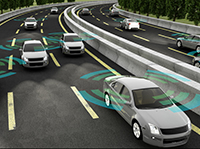|
 The Peugeot instinct concept car has been designed to fulfill its owner's desires. A concept car is a real car but made to showcase a future or emerging technology. The concept car has four different settings: two active-driving modes and two self-driving modes. The Peugeot instinct concept car has been designed to fulfill its owner's desires. A concept car is a real car but made to showcase a future or emerging technology. The concept car has four different settings: two active-driving modes and two self-driving modes.
The active-driving mode Drive Boost is for a fully dynamic drive, whereas the Drive Relax mode uses advanced driving assistance systems to assist the driver. Furthermore, Autonomous Sharp is for daily commuting and optimizes journey times with precise, efficient road handling, whereas Autonomous Soft, intended for longer journeys, is for comfort and enables the possibility to watch a film, read, or rest.
The car preconfigures a range of features such as driving mode, seat and interface settings, ambient lighting, and a hi-fi system. However, the driver remains fully in control and able to choose between driving manually or letting the car do the work in an autonomous mode.
According to China Daily, the city of Zhangzhou is planning to build the world's largest experimental zone for autonomous driving, which is expected to be open by the end of the year. The zone will consist of three parts: 1) a 56 km2 zone for testing autonomous cars in a city-level lab road network with complete traffic signs, 2) a 600,000 m2 closed testing ground, and 3) a 2-million-m2 open experimental field.
China Daily also reports that the China Merchants Group, Front Capital, and the CRI Intelligent Auto Research Institute have decided to set up an initial fund of 10 billion ¥ for the project. Mcity, a test facility for connected and automated vehicles built by the University of Michigan and the Michigan Department of Transportation, will offer technological suggestions to the project.
The German Federal Cabinet has adopted a draft law for automated driving as an amendment of the Road Traffic Act. The core of the law is the legal equality of a human driver and a computer. Highly or fully automated driving systems are thus, in the future, able to completely take over the driving process.
The law requires the human driver to interact with the vehicle control system only when the highly or fully automated system requires it or if the conditions for the intended use of the automated driving system no longer exist, e.g., in the case of a flat tire. To assess the liability of the human driver and the autonomous system in the case of incidents, a data storage device in the form of a black box is required.
Autonomous driving can be an incredibly computation-intense process; thus, an efficient AI processor is required. Xavier, Nvidia's new AI supercomputer, is designed for use in self-driving cars. Xavier is a complete system-on-chip with a processor delivering 20 trillion operations per second while consuming only 20 W of power.
Xavier is designed to be compliant with critical automotive standards, such as the International Organization for Standardization (ISO) 26262 functional safety specification. It also has AI Copilot capabilities, so when the car is not in an autonomous mode, it can act as a copilot, alerting to dangerous situations on the road and recognizing driver identity, knowing where the driver is looking, and reading lips to understand commands in noisy situations.
Nvidia has announced a series of new partnerships to continue to build its platform and accelerate the development of self-driving cars. With its long-time partner Audi, the company promises that Level 4 autonomous driving in production cars will be achieved no later than 2020.
In addition, cars from Mercedes-Benz will incorporate products built with Nvidia before 2018. Bosch and ZF, both tier 1 auto suppliers, have adopted the DRIVE PX car computer. In addition, Nvidia collaborates with ZENRIN, HERE, Baidu, and TomTom for high-definition mapping.
Full article: IEEE Vehicular Technology Magazine, Volume 12, Number 2, June 2017 |